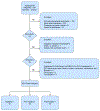Intraoperative electroencephalographic marker of preoperative frailty: A prospective cohort study
- PMID: 36738630
- PMCID: PMC10074446
- DOI: 10.1016/j.jclinane.2023.111069
Intraoperative electroencephalographic marker of preoperative frailty: A prospective cohort study
Abstract
Trial registration: ClinicalTrials.gov NCT04783662.
Keywords: Clinical frailty scale; Electroencephalography; Frailty; Fried phenotype; Intraoperative; Surgery.
Conflict of interest statement
Declaration of Competing Interest Dr. Westover holds stock in Beacon Biosignals, the makers of EEG analysis software. He is not conducting any research sponsored by this company. All other authors state that there have been no involvements that might raise the question of bias in the work reported or in the conclusions, implications, or opinions stated.
Figures




References
-
- Fried LP, Tangen CM, Walston J, Newman AB, Hirsch C, Gottdiener J, et al. Frailty in older adults: evidence for a phenotype. J Gerontol A Biol Sci Med Sci 2001;56:M146–56. - PubMed
-
- McIsaac DI, MacDonald DB, Aucoin SD. Frailty for perioperative clinicians: a narrative review. Anesth Analg 2020;130:1450–60. - PubMed
-
- McIsaac DI, Taljaard M, Bryson GL, Beaule PE, Gagne S, Hamilton G, et al. Frailty as a predictor of death or new disability after surgery: a prospective cohort study. Ann Surg 2020;271:283–9. - PubMed
Publication types
MeSH terms
Associated data
Grants and funding
LinkOut - more resources
Full Text Sources
Medical

